Picking up where I left off a few weeks ago with looking at some of the ocean fish that are available here, today we’ll hit a couple of common ones, but mostly, some that aren’t seen all that often. It’s more a function of what photos I happen to have than anything else. More to come down the line…
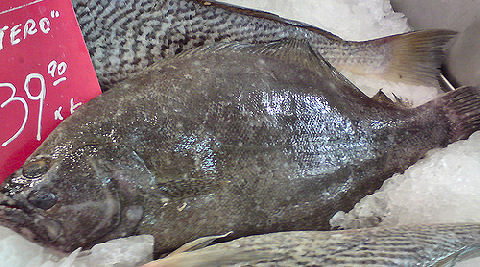
Let’s start with a couple of more common ones, in this case, the Lenguado (Paralichthys orbignyanus), or Large-Tooth Flounder, found off the coasts of northern Argentina, Brazil, and on the other side of the continent, very common in the coastal waters of Peru. Ranging from fairly small to just shy of two feet in length (20-50cm), this is a flatfish that has a very delicate flavor, virtually no spines, is easy to work with, and absolutely delicious. In Peru it’s generally considered the finest fish to use for ceviche, and that’s what we tend to use it for as well, though given its cost, it’s not used as often as some of the other fish available, particularly in casual cevicherias. Here, it’s getting fairly expensive and I’ve recently seen prices that range anywhere from 70 to 95 pesos a kilo.
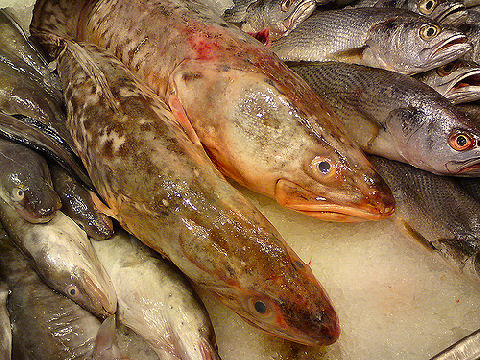
Next up, the fairly common and also fairly pricey Abadejo (Pollachius pollachius), or Pollack. A meaty white fish, the fillets tend to be thick, often as much as 3 centimeters, or a bit over an inch, and are great for baking, broiling and grilling. They tend to have a thin belly flap that most markets here leave attached, and most of the bones seem to be in that flap, making it fairly easy to simply slice off. You will find a few scattered pin bones in other parts of the fillets but they’re also quite easy to remove. These are fast growing fish that can get fairly large, coming in at 30-50 inches in length, 75-125cm, and the larger ones can weigh in at close to 40 pounds, 18 kg, though those aren’t commonly seen. One more economical thing to look for, these fish are big enough to have cachetes, cheeks, that are great to use in fish chowders and stews as they hold together nicely (just remove the single cartilage disk from each), and usually running about half the cost of the fillets.
Recipes: Abadejo a la chanfaina
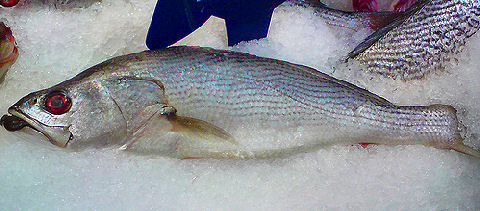
In the same family as the Corvinas that I covered in the last post, the Pescadilla (Cynoscion striatus), a type of Drum called the Striped Weakfish. These fish run about 12-18 inches (30-45cm) in length and, I’ve often seen them displayed at some of the less reputable fish markets as the more sought after Corvina. Personally I’m not fond of the fish, I find it to be kind of flavorless and the fillets tend to shred or flake apart when cooked. I haven’t even seen many interesting local recipes for them – mostly they seem to be baked whole, stuffed with herbs or some other filling, or used chopped up as filler in fish stuffings or ground as part of fish patties or balls. I suppose they might help fill out a gefilte fish recipe paired with other fish.
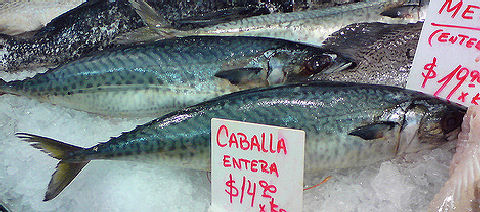
The Caballa (Scomber japonicus), or Pacific Chub Mackerel, comes from the other side of the continent and differs only slightly from the Atlantic Chub Mackerel, which, as best I can determine, isn’t available here as it comes from the Mediterranean and the Black Sea. I rarely see these fresh here in town – now and again at some of the better markets. They do show up canned on supermarket shelves, often layered with an herbed tomato sauce. Henry likes to use those tossed with pasta. Fresh, I don’t often use mackerel, but they’re great for sashimi if they’re very fresh, and I’ve cured them or smoked them and used them on a cold fish appetizer plate a few times. Typically they’re relatively small, under a foot (30cm) in length, though they can grow to double that size.
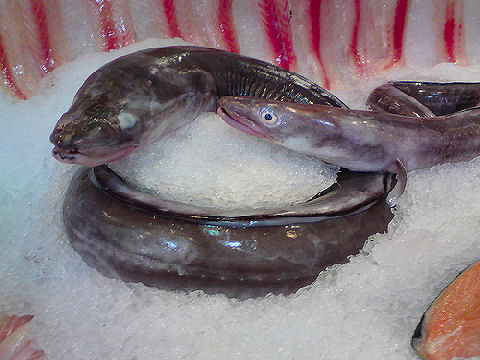
I almost never see this fish, or eel, the Argentine Conger – Congrío (Conger orbignianus). Bluntly, eels are a pain in the ass to cook with, just peeling the rubbery skin off and then filleting them without hacking them to pieces is more work than I’m usually willing to put in. Still, now and again, smoked eel or pickled eel, or who knows, maybe and eel pie might be in order. And, of course, they’re the classic fish used in Chilean caldillo de congrío, though I often use the aforementioned pollack cheeks as they’re texturally similar and much easier to obtain. They’re a long, skinny fish, running over a meter in length on up to about a meter and a half (39-60 inches), but they’re so thin that there’s not a lot of meat on the fillets. When it comes down to it, I think I’ve seen them here twice in eight years, so not something that shows up on the typical bed of ice.
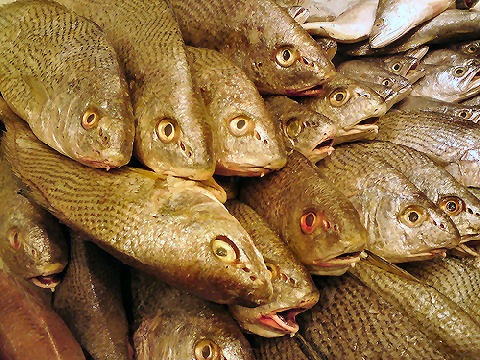
Another fish I rarely see, though more and more common in Barrio Chino, is the Pargo (Umbrina canosai), or Argentine Croaker. It’s often touted as Red Snapper or just Snapper on menus, but it’s really a completely unrelated fish to that family, though outside of Argentina that can be a correct translation. Just not here, where the closer fish to the snappers would be the Besugo that I covered in the last post. Still, these fish have a similar flavor and cook up nicely like snapper, so it’s not a far stretch to use them in place of one in a recipe. I like to fillet them and cook the fillets with herbs and vegetables all wrapped up in foil or parchment paper – they hold together nicely and cook up to a very delicate and delicious meal. The fish run a little over a foot in length when fully grown, somewhere around 35cm.
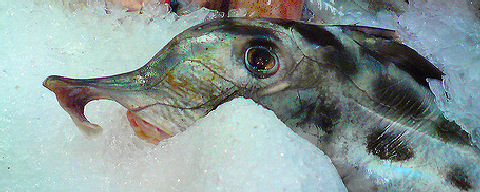
Although this showed up one day in the market as a Pez Angel, or Argentine Angelshark, it’s clearly not if you look at any photos of that tasty beast. It’s a Pez Gallo (Callorhynchus callorhynchus), officially a Plownose Chimaera, though more commonly referred to as an Elephant Fish (and sometimes called Pez Elefante, since “gallo” would be a rooster). This is the only time I’ve ever seen one whole, they’re quite common already filleted, and not all that interesting – usually just filled with cartilage that make them near impossible to work with. Although I see them all the time ready for cooking, no one’s ever given me a decent recipe for them, and they’re usually sold pretty cheaply. In fact, a search for recipes yielded pretty much nothing. I’ve tried working with them and at best end up with some cubes of meat that can be added to a chowder or stew.
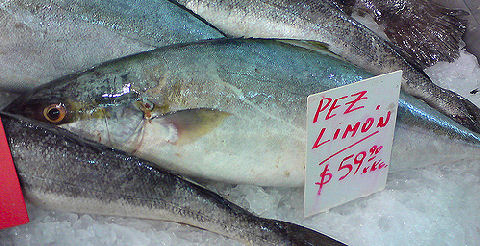
And finally, for this post anyway, the Pez Limón Seriola lalandi, or Yellowtail Amberjack. These fish come in everywhere from small to huge, they can hit 250cm or 100 inches in length and are a great sport fish. This is a close relative to the yellowtail that we know and love in the States in sushi bars as hamachi, though a different species in the same genus. And, at a couple of the better sushi bars in town it has sometimes been available and tastes fairly similar. I’ve actually not worked with this fish at all here, so can’t give any personal recommendations, but many of the recipes I’ve seen tend towards Asian flavors, to which it likely takes quite well. Gives me some ideas for things to try out soon.
And, on we go. Next time, we’ll see what other fish are out there in the markets.
Thanks again for the article. It will make my fish shopping easier next time I am in BA.
Such a great post, but I actually love Angel fish and always buy it if I see it. I normally buy it in filet.
My recipe (very basic, but I often serve for company):
In an “essen” pot (I think they are called dutch oven, basically a thick pot with a lid) put a bit of oil to heat. Add sliced onions, carrots, red bell pepper, potatoes. Cover on medium heat. Once vegetables are cooked in their own juices, about 20 minutes, stirring ocassionaly, add the fish on top, plus a bit of garlic, lemmon and soy sauce. Once fish is cooked through and falls off the bone (about 3 minutes) serve dressed with chopped parsley, a touch of olive oil and lemmon on the side.
Variation: add diced tomatoes to make it more juicy. Can also be cooked in the oven.
This isn´t an Argentine recipe, but I can get even an Argie fish hater to eat fish this way.
[…] bit first. Today is going to be another step-by-step in the fish world. The fish, locally known as abadejo (or in Chile, congrio, which everywhere else refers to a conger eel, go figure), in English, […]